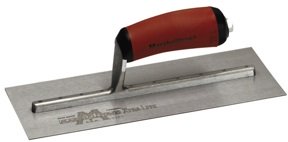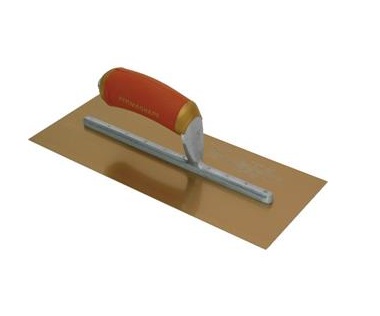Which Plastering Trowel to Buy?

There is a short and a long answer to which plastering trowel is best. The main difference addressed here is size - a short trowel (11 inches) and a long trowel (13 inches plus).
The Short Answer
The longer the trowel - the more pressure or a greater technique is required. The shorter the trowel - the greater chance of ensuring the trowel is in contact with all parts of the wall surface, and of obtaining a uniform finish.
Being able to apply firm pressure combined with the correct angle of your trowel ensures a flat and even finish. If in doubt a smaller trowel will be easier to control and generally be the safest bet.
Will a smaller trowel leave more trowel marks?
Trowel marks are never a problem and having a longer trowel in the hope that less trowel marks are left, is totally wrong. In fact it may be that the opposite is true - if the trowel is too big and sufficient strength or technique are not used, to keep the plaster flat, then trowel marks may never come out due to the trowel not sitting flat upon the wall.
If the correct process and objectives are followed the plaster will be trowelled flat. Then when a flat surface is achieved the trowel will always be sitting flat on the wall and before you know it trowel marks will just disappear - when the plaster is firm enough. If they don't and you have always focussed upon flatness then the chances are the plaster is too wet - let it firm up and when it is quite firm they'll just push out and disappear whilst you are ensuring all hollows are filled.
Plastering Trowels need to be Worn In
All trowels need wearing in - even one sold as pre-worn in often need a bit more attention. Details regarding How to wear your trowel in are here.
Which Plastering Trowel - The Long Answer
There are so many different makes, models and sizes of plastering trowel. Which plastering trowel is the best for you depends upon
- Your experience/ability
- Your strength
- The wall
- How often you'll be plastering
Most plasterer's have a trowel for applying base coat and a different trowel for the finish coat - as well as smaller midget trowels for smaller awkward areas.
Your Strength
Which plastering trowel you would be best to buy depends upon how strong your plastering arm is! The pressure applied to the trowel needs to be great enough to ensure the plaster is forced across the whole length of your trowel to give a nice flat finish. If this doesn't happen and the trowel is not in contact with all parts of the surface - there may be many hollow areas untouched by the trowel. Maximum pressure will ensure the trowel is in contact with all areas of the surface.
If you do not have the strength to provide adequate pressure then a smaller trowel is preferable or both application technique and trowelling technique needs to be good.
Your Experience/Ability
When applying the plaster - if the required pressure can not be applied due to a lack of strength, then the angle to which the trowel is away from the wall is even more important. In the absence of strength proper technique will be vital.
When trowelling the plaster - If the trowel is almost flat to the wall then there will be more surface area of the trowel on the wall and therefore more pressure needed. If the trowel or the leading edge of the trowel is further away from the wall there will be less surface area of the trowel in contact with the wall and the trowel will act as a scraper.
The three trowelling techniques are: firm pressure (to force the highs into the lows), filling the hollows (applying more plaster where needed), or scraping and filling (scraping plaster off the highs to use for filling the lows) .
If you are in the process of learning these techniques then a smaller trowel (11 inch) may be preferable.
Which Plastering trowel to buy is influenced by the wall
If the walls or areas that you're intending to plaster are small - a long trowel can be awkward and cumbersome.
How often will you be plastering?
The Manufacturer
If you want a trowel to last for many years - one that will withstand general wear and tear, a make called Marshalltown will serve you well (easily available on the internet). However if you are just plastering now and again a trowel from any DIY store will be fine - but the cheapest may not be the best as sometimes they are too rigid, too flexible or have the wrong balance/feel. The most expensive own brand or mid range specialist plasterer's finishing trowel should hopefully do what it says. if in doubt you can't go wrong with a Marshalltown.
The Rust Issue
If your trowel is used regularly then it will not have the chance to go rusty - as just a few days is all it can take for rust to appear. A stainless steel trowel that will not rust can be beneficial.
Stainless steel trowels are great - but they tend to lose their shape quite easily and develop a bend. This is not a problem as it is just a case of getting use to the leading edge of the trowel being further away from the wall than the standard 10-15mm. However Marshalltown sell a Gold Stainless Steel Permashape trowel that will not distort and bend.
 A Gold Stainless Steel Trowel to retain it's original shape
A Gold Stainless Steel Trowel to retain it's original shape
Which Plastering Trowel is best for backing coat?
When applying the backing coat the trowel should be viewed as applying the correct thickness of plaster - it will not successfully flatten the plaster, the straight edge is designed specifically for this purpose. Therefore you can get away with virtually any trowel for applying the base coat due.A plasterer will tend to have a different trowel for applying the base coat due to the roughness of the work. The plaster is being applied to rough masonry walls and it can be very easy to damage the fine edge of the trowel on any metalwork or masonry protruding from the wall.
Application of the Finish Coat requires the edge of the plastering trowel has to be perfectly flat, smooth and free from any nicks - if a good finish is to be obtained so whereas any trowel can be used for the backing coat a good trowel that is in good condition is a must if a good finish is to be achieved.
Plastering Trowels need to be Worn In
All trowels need wearing in - even one sold as pre-worn in often need a bit more attention. Details regarding How to wear your trowel in are here.
Which Plastering Trowel is the safest option.
If you are still unsure which plastering trowel to buy you wont go wrong with an 11 inch Marshalltown finishing trowel. A choice of wooden or durasoft handles is available and really is personal preference. The durasoft is as it says just a bit softer. If rusting may be a consideration then you can choose a stainless steel version.
Marshalltown tools are readily available from all sorts of sites. The American manufacturer's website that shows the rang of trowels, however many of the trowels often appear in the concrete finishing section as well as the plasterers section. However if in doubt a reputable British supplier should be able to help.